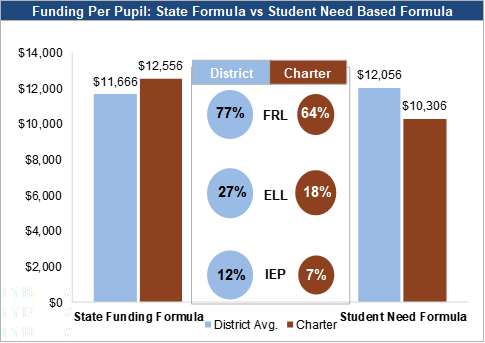Effective Governance, Financial Sustainability
Affording Quality Schools – Solutions and Remedies 1 and 2: Reinventing Funding Formulas and Services with Costs That Seem Fixed

Solutions to Affording Quality Schools
At Afton, our work with school districts throughout the country affords us an opportunity to appreciate the complexities that school districts face to reduce costs during periods of enrollment decline. And our work with charter school operators also affords us the opportunity to appreciate how school choice can change the lives of students who have otherwise limited options.
So how can quality charter schools be afforded without financially harming district-run schools?
Afton identified 8 ways that school districts can mitigate the effects of enrollment decline (and these were highlighted in CRPE’s “Better Together: Ensuring Quality District Schools in Times of Charter Growth and Declining Enrollment”):
- Uniform intra-district funding formula for district and charter schools
- Continued operational efficiencies, with an eye toward making costs more variable
- School closures and corresponding real estate transactions
- Redistricting / efficient enrollment planning
- End “last in first out” methods of reducing staff
- End unsustainable/unfunded salary commitments (step/lane/raise)
- End proliferation of long-term fixed cost obligations (pension/OPEB)
- District commitment to decision-making based on long-term planning
None of these actions are easy. All require changes to institutionalized policies and practices. These actions displease stakeholders in the short term, as the benefits are ones of avoidance of fiscal insolvency rather than gaining programming from what exists today.
In the next few parts of our series, Afton will provide some context for some of these remedies to the negative fiscal impacts of enrollment decline in school districts. Today, we will highlight remedies 1 and 2.
Affording Quality Schools – Remedies 1 and 2: Reinventing Funding Formulas and Services With Costs That Seem Fixed
Enrollment losses are challenging to districts financially. But when charters come into the picture, there are additional complexities to address in long-term planning. Not only is the District losing enrollment, it is also often adding the service of being an authorizer and changing services by being an LEA to a different kind of customer. To ensure they meet these obligations and do so cost-effectively, districts should consider (a) implementing a student need-based funding formula and (b) restructure central and shared services to adapt to the differing needs of charter schools vs. district-run schools.
(1) Implement a student need-based funding formula for all schools including charter schools. If the district cannot control the charter funding formula, then lobby the state to ensure an equitable formula is in place. It is critical that certain “city-wide” obligations are considered in the funding formula, such as SPED outplacement, adjudicated students, etc. Additionally, other fixed or semi-fixed costs should be considered, including debt service and legacy pension. Notably, equitable funding formulas must reflect student needs. Below is an example of a small district in Illinois with an authorized charter school. State guidelines for funding use historical data and do not differentiate by student need. As we can see in the chart below, this state funding method for charter schools did not demonstrate equity. The charter school has significantly lower student needs, but would have received more money out of dollars available for K-12 education. In an agreed-upon equitable formula between the charter school and the school district, the charter school receives less than the state guidelines, primarily because its student population is recognized as lower needs.

(2) Create efficiencies and opportunities for variable costs in otherwise “fixed” cost services. As charters become a bigger proportion of total schools supported by the district, districts have an opportunity to restructure school design and centralized services to accommodate (a) a loss of enrollment, and (b) a different type of customer with different needs.
As enrollment declines within schools, it does not typically reduce a whole classroom in a grade – it more often looks like several students leaving each grade, making it more difficult for traditional school structures to reduce costs (and staffing) in proportion to the enrollment loss. Schools with more flexible designs, such as multi-age classrooms, personalized learning instructional methods, and reimagined school staffing structures, experience more variable cost structures, serving as an advantage to preserving high-quality instruction as enrollment declines. Collective Bargaining Agreements should be reviewed to understand constraints that may be present to the District’s ability to reduce or move staffing as enrollment declines or fluctuates. Possible constraints include class size maximums, termination provisions, severance obligations, post-retirement health plan benefits, and shared service workload minimums. These constraints, if present, should inform priorities in future collective bargaining discussions.
Outside of schools, the same kind of reimagination is required as enrollment declines. Districts should review each central service and shared service department (HR, IT, finance, etc.) and align its staffing and structure to the anticipated needs of the charter schools. During this review, each department’s role should be defined – what is the department’s purpose, what activities is it responsible for related to charter schools, and what activities is it responsible for related to district-managed schools. Capital planning could be incorporated into this review process. Given anticipated changes in enrollment mix over the longer term, how will the levels and types of activities in each department need to change? Outsourcing certain non-core services becomes an interesting option as it shifts the burden of staffing and related fixed costs outside of the school district and enables the costs of these services to become more variable. To the extent that districts have contractual obligations with service vendors, they should ensure that any longer-term contracts do not have service minimum requirements and offer flexibility so that districts can reduce services as there are changes in the numbers of students served and buildings operating.
- For the introduction to this series: Defining the Problem
- Read more with part 2: Affording Quality Schools: Remedies 3 and 4